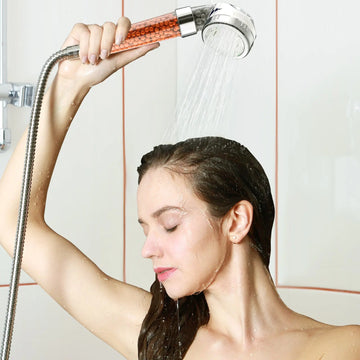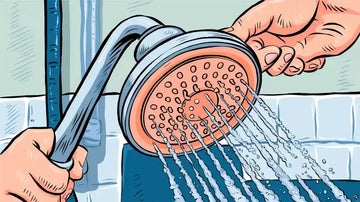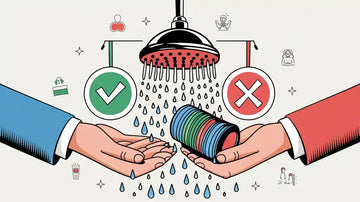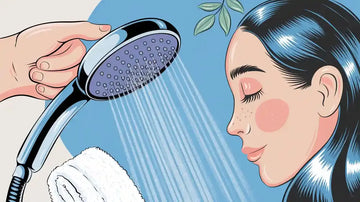Imagine walking into your bathroom and turning your shower into a spa. Picking the right rainfall shower head isn’t just about how it works—it’s also about making your bathroom look better and your showers more relaxing.
Why is this important? Research shows rainfall shower heads with good spray areas and even water flow make people happier. They create a soft, calming stream that feels fancy compared to regular showers. Also, efficient models, like WaterSense ones, can save about 2,700 gallons of water each year—helping the Earth and saving you money.
When planning your bathroom makeover, think about what style you like. Whether it’s a simple black ceiling shower head or a shiny square wall-mounted one, the right choice can improve your bathroom. By thinking about spray patterns, water pressure, and design, you’ll find the best shower head for you.
Key Takeaways
Rainfall shower heads give a relaxing shower, like a spa.
Picking the right size and height gives smooth water flow.
Choose water-saving models to save money and help nature.
Adjustable spray settings let you change the shower to match your mood.
Cleaning nozzles often helps your shower head last longer and work better.
What Is a Rainfall Shower Head?
Definition and Features
A rainfall shower head is made to feel like soft rain. It gives a calm and relaxing shower experience. Unlike regular shower heads, it has a big surface that spreads water evenly. This design makes showers more comfortable and adds a fancy touch to your bathroom.
Here’s a simple look at its main features:
Feature |
Description |
|---|---|
Surface Area |
Big panel spreads water evenly, like natural rain. |
Design |
Stylish and modern, making your bathroom look better. |
Materials |
Strong materials like stainless steel last long and are easy to clean. |
Technology |
Special nozzles keep water flowing smoothly with good pressure. |
Functionality |
Feels like a spa, mixing relaxation with daily use. |
These features make a rainfall shower head a great pick for anyone wanting a better shower.
Differences Between Rainfall and Other Shower Heads
Not all shower heads are the same. Rainfall shower heads are special because of their design and how they work. Here’s how they are different:
Coverage: Rain shower heads cover your whole body, while regular ones focus on smaller spots.
Water Flow: They give a smooth, steady stream like rain. Regular ones spray water in a stronger, smaller stream.
Installation: Rainfall heads are placed on the ceiling or high on the wall. Regular ones are usually angled on the wall.
Experience: A rain shower feels calm and fancy, like a spa. Regular ones are more about getting the job done.
With these differences, it’s easy to see why rainfall shower heads are so popular. They mix style, comfort, and usefulness, turning every shower into a relaxing escape.
Choosing the Right Shower Head for Your Home
Size and Coverage
The size of a shower head affects your shower experience. Rain shower heads are bigger than regular ones. They spread water evenly, feeling like soft rain. Most are 8 to 12 inches wide, but larger ones, like 16-inch models, cover your whole body.
The height of the shower head is important too. Experts say it should be 6.5 to 7.2 feet above the floor. This height helps water flow evenly without losing pressure. If you're redesigning your bathroom, think about where to place it for the best look and use.
Tip: Want more options? Choose a combo with a handheld shower head. It’s useful for cleaning hard-to-reach spots or your shower walls.
Water Pressure Compatibility
Water pressure matters when picking a rain shower head. These heads give a gentle flow but need enough pressure to work well. If your home has low water pressure, the shower might not feel great.
Some states limit how much water shower heads can use. For example:
State |
|
|---|---|
California |
1.8 |
Colorado |
2.0 |
New York |
2.0 at 80 PSI |
West Hollywood |
1.5 (WaterSense) |
If your area has strict rules, look for WaterSense models. They save water while still giving a good spray.
Note: Check your water pressure before buying. Most rain shower heads work best with 2.0 to 2.5 GPM. If your pressure is low, try a high-pressure model or ask a plumber for help.
Spray Patterns and Water Efficiency
Spray patterns change how your shower feels. Rain shower heads usually have wide sprays, but some offer mist, massage, or waterfall settings. Adjustable sprays let you pick between relaxing or energizing showers.
Saving water is also important. Many modern rain shower heads use air-injection technology to keep strong pressure while using less water. Some models save 20% more water without losing performance.
Here’s a comparison of popular choices:
Product Name |
Water Saving |
Spray Options |
Extra Features |
|---|---|---|---|
Delta Faucet Modern Showerhead |
Saves 20% |
N/A |
WaterSense, easy to install |
Danze D460035 Florin Showerhead |
Saves 20% |
5 Spray Settings |
Durable design, D-Force Technology |
Speakman High Pressure Adjustable Head |
N/A |
Multi-Function Spray |
Strong brass build, adjustable spray |
Think about how often you’ll use different spray settings. If you like simple showers, a single-pattern head is fine. But if you want variety, pick one with multiple options.
Pro Tip: Choose self-cleaning nozzles to stop clogs and keep the spray working well.
Material and Finish
When choosing a rain shower head, the material and finish play a big role in durability and style. You want something that lasts but also looks great in your bathroom. Let’s break it down.
Common Materials
Different materials offer unique benefits. Here’s a quick comparison to help you decide:
Material |
Durability Characteristics |
|---|---|
Brass |
Strong and long-lasting. It won’t rust or corrode, making it ideal for wet environments. |
Stainless Steel |
Lightweight and resistant to rust and stains. Perfect for a sleek, modern look. |
Plastic (ABS) |
Affordable and durable. It’s resistant to chemicals and corrosion, but it may not feel as premium. |
Chrome |
Shiny and stylish, but it can show water spots easily. |
Brushed Nickel |
Matte finish that resists fingerprints and spotting. It’s a great choice for a low-maintenance option. |
If you’re looking for a luxurious feel, brass or stainless steel is the way to go. For a budget-friendly option, ABS plastic works well without compromising functionality.
Choosing the Right Finish
The finish isn’t just about looks—it also affects maintenance. Polished finishes like chrome or brass add a shiny, elegant touch but may require frequent cleaning to avoid water spots. On the other hand, brushed finishes like nickel or stainless steel hide smudges and are easier to maintain.
Tip: Match the finish of your rain shower head with other fixtures in your bathroom for a cohesive look.
Installation and Maintenance
Installing a rain shower head might sound tricky, but most models are designed for easy setup. You can often do it yourself without professional help.
Installation Tips
Here’s a simple guide to get you started:
Remove your old shower head by unscrewing it from the pipe.
Clean the threads on the pipe to remove any debris or old tape.
Wrap plumber’s tape around the threads to ensure a tight seal.
Screw on your new rain shower head by hand. Tighten it gently with a wrench if needed.
Most rain shower heads come with standard fittings, so they’ll work with your existing setup. If you’re upgrading to a ceiling-mounted model, you might need professional assistance to adjust the plumbing.
Maintenance Tips
To keep your shower head working like new, regular maintenance is key:
Clean the nozzles: Use a toothbrush or your fingers to remove mineral buildup.
Check for leaks: Tighten connections or replace washers if you notice drips.
Flush the system: Remove the shower head and run water through it to clear any blockages.
Pro Tip: If you live in an area with hard water, consider a model with self-cleaning nozzles or an integrated filter. This will reduce buildup and extend the life of your shower head.
Budget Considerations
Your budget doesn’t just determine what you can afford—it also impacts your long-term savings. A rain shower head might seem like a splurge, but it can save you money in the long run.
Cost vs. Value
Modern rain shower heads are designed to use less water without sacrificing performance. Before 1994, shower heads used up to 5.5 gallons per minute (GPM). Today, most models are capped at 2.5 GPM, and some states require even lower limits. This means you’ll save on both water and energy bills.
Low-flow models are a smart investment. They reduce water usage while maintaining a luxurious shower experience. If you’re unsure about your current shower head’s flow rate, here’s a quick test:
Place a 5-gallon bucket under your shower.
Turn the water on full blast for 60 seconds.
Measure how much water is in the bucket.
If it’s more than 2.5 gallons, switching to a low-flow rain shower head could save you money.
Finding the Right Balance
You don’t have to break the bank to get a high-quality shower head. Look for models that offer a good mix of features, durability, and efficiency. For example, the Cobbe 12 Inch All Metal Rain Shower Head combines a luxurious design with advanced filtration and easy installation—all at a reasonable price.
Note: Investing in a durable, efficient shower head might cost more upfront, but it pays off in savings and a better shower experience over time.
Exploring Extra Features
LED Lighting Choices
Picture stepping into your shower with soft lights glowing. Some rainfall shower heads now have LED lights that change colors. These lights show if the water is hot or cold. They make your shower look fancy and help keep you safe.
Why LED lights are great:
Ambiance: They make your bathroom feel like a spa.
Safety: Lights warn you about hot or cold water.
Energy Saving: Water flow powers the lights, so no batteries needed.
Want a cooler shower experience? LED lights are fun and useful.
Anti-Clog Designs
Clogged shower heads are annoying. Anti-clog designs fix this problem. Self-cleaning nozzles stop mineral buildup and keep water flowing well. You’ll clean less and enjoy your shower more.
Tests show anti-clog nozzles keep strong water pressure over time. Families love them because they rinse shampoo easily from all hair types.
Tip: Hard water areas benefit from anti-clog designs. They reduce cleaning work.
Adjustable Settings for Personal Use
Every shower feels different, and adjustable settings let you choose. You can pick a mist, massage, or waterfall spray. These settings make your shower fit your mood.
Why adjustable settings are popular:
Comfort: Change spray and pressure to match what you like.
Safety: Valves keep water temperature steady, avoiding surprises.
Versatility: Great for homes with older pipes or uneven pressure.
Many people love adjustable settings for their ease and comfort. They’re perfect for dual shower systems with both rainfall and handheld options.
Looking for a shower head that fits your needs? Adjustable settings are a smart choice.
Spotlight on Waterfall Shower Heads
Benefits of Waterfall Shower Heads
A waterfall shower head can make your showers feel special. Instead of spraying water like normal, it pours water smoothly, like a real waterfall. This design makes showers calm and fancy, right in your home.
Why do people love these shower heads? Here are the main reasons:
Relaxation and Stress Relief: The soft water flow helps you relax and feel peaceful.
Water Efficiency: New models cover your body well but use less water.
Therapeutic Effects: The gentle water feels nice on your skin, like a spa.
Here’s a quick summary of their benefits:
Benefit |
Description |
|---|---|
Enhanced Showering Experience |
The soft water flow creates a peaceful vibe, helping you relax. |
Water Efficiency |
Modern designs give full coverage while saving water. |
Therapeutic Effects |
The smooth water feels natural and soothing, improving your shower. |
More people want these shower heads because bathrooms are now seen as relaxing spaces, not just places to get clean.
How They Differ from Rain Shower Heads
At first, waterfall and rain shower heads might look alike. Both make showers better, but they work differently.
Waterfall shower heads are usually mounted on the wall and have a long, rectangular shape. They pour water with more force, great for people who like stronger showers. Rain shower heads are wider, often on the ceiling, and give a soft, rain-like flow.
Here’s a comparison to help you choose:
Feature |
Rainfall Shower Heads |
Waterfall Shower Heads |
|---|---|---|
Appearance |
Wide, flat, and often placed on the ceiling |
Long, rectangular, and mounted on the wall |
Intensity |
Soft water flow, gentle and calming |
Stronger water flow, more energizing |
Water Pressure |
Needs good water pressure to work well |
Works best with steady, strong water supply |
Comfort Experience |
Great for peaceful, spa-like showers |
Perfect for bold, refreshing showers |
Your choice depends on what you like most. If you want a calm, spa-like shower, go for a rain shower head. If you prefer a strong, energizing shower, pick a waterfall shower head.
Tip: Check your bathroom’s setup and water pressure before buying. Both types can turn your shower into a relaxing getaway.
Picking the best rainfall shower head can change your day. Think about size, water pressure, materials, and features. These help you find one that suits your needs. Many people now want designs that save water and can be adjusted. Features like spray settings and strong materials make showers better and look nicer.
Buying a good shower head isn’t just useful—it feels fancy too. Whether for comfort or style, the right one makes your bathroom feel like a spa.
FAQ
How do you install a rainfall shower head?
Installing a rainfall shower head is simple. First, take off the old shower head. Clean the pipe threads and wrap them with plumber’s tape. Then, screw on the new shower head tightly. For ceiling-mounted models, you may need a plumber to help.
Can rainfall shower heads work with low water pressure?
Yes, they can! Pick a model made for low pressure. Some use air-injection technology to keep water flowing well. Before buying, check your home’s water pressure to make sure it works.
How do you clean and care for a rainfall shower head?
Cleaning is easy. Scrub the nozzles with a toothbrush to remove buildup. For deeper cleaning, soak the shower head in vinegar for a few hours. If you have hard water, choose a shower head with self-cleaning nozzles or a built-in filter.
Are rainfall shower heads good for saving water?
Yes, many are designed to save water. Look for WaterSense-certified models or ones with air-injection technology. These features use less water while still giving a great shower. They’re eco-friendly and save money too.
What should you look for in a rainfall shower head?
Think about size, spray options, material, and water-saving features. Adjustable settings and anti-clog designs make them easier to use. For a fancy feel, look for extras like LED lights or filters. Use this guide to find the best one for you.







